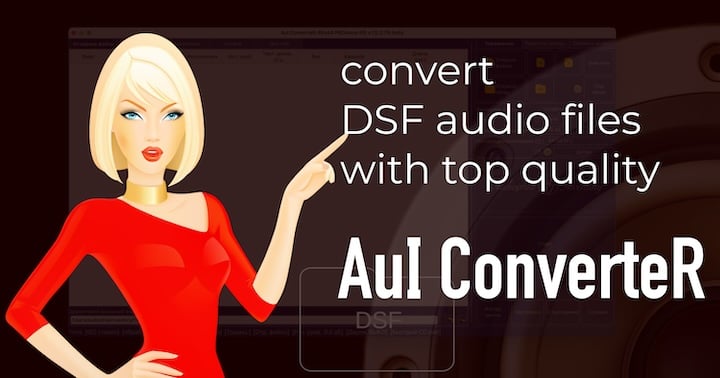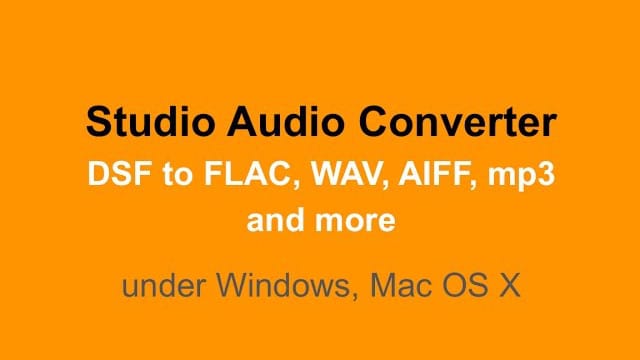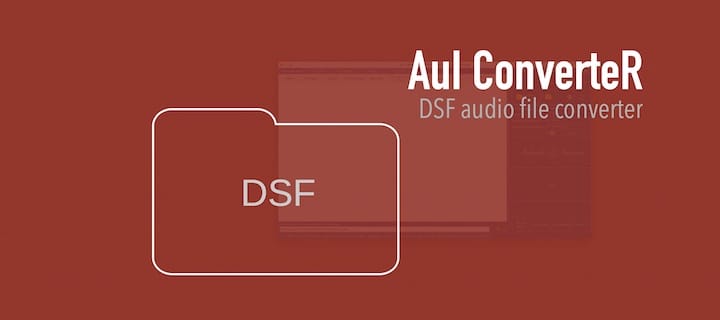
AuI ConverteR 48x44 is a DSF converter to/from WAV, FLAC, AIFF, DSF, DFF files. Extraction of SACD ISO to DSF is supported. Sample rates: 44.1 kHz ... 1536 kHz / 2.8 (DSD64) / 5.6 (DSD128) / 11.2 (DSD256) / 22.5 (DSD512) / 45.2 (DSD1024) MHz. The software is intended for audiophiles and music production. Operating systems: Mac OSX, Windows.
Read about sound quality and DSD formats below.

If you buy "AuI ConverteR PROduce-RD" (2023/12.x version) from 24 August 2023 to 24 October 2023, you will get free update to version 2024 (13.x) after its release.

Back to top
General issues
Aims of music conversion:
- format adjusting (DSF, DFF, FLAC, WAV, SACD ISO, etc.) to hardware/software abilities,
- resolution adjusting [sample rate, bit depth, 1-bit sigma-delta modulation (a.k.a. DSD) or PCM] to hardware/software abilities,
- using of audio system resolution, which causes lesser distortions.
DSF file description
DSF is an audio file format (.dsf extension) with a high-resolution DSD stream (1-bit sigma-delta modulation).
Simplified DSF file structure:
- header
- DSD sound data
- id3 metadata block.
See below the link to the format specification.
The DSD data is divided into blocks. The last block may be filled partially. If a software or hardware ignore it, audible pops may be caused.
Stereo 2.0 and multichannel 5.1 formats are supported. Also, another channel number may be supported.
DFF file is an alternative container for DSD sound format. A DSD converter between these file types (containers) may support a lossless re-pack of binary identical musical content.
AuI ConverteR has such an ability, that is called "bit-perfect" mode. Go to Settings, General tab, and check "Don't make DSP..." switch. In the main window, set Sampling rate "as input".
If you convert DSD to PCM files, set Sampling rate and bit depth explicitly.
Music playback, DSP
Music players are able to playback 1-bit Direct Stream Digital stuff straight on DSD DAC (native 1-bit DAC) or convert in real-time ("on fly") DSD to PCM format to feed PCM DAC.
Conversion of 1-bit sigma-delta modulation to PCM is lossy. Physically the conversion is filtering high-frequency noise. The filtering band may have different widths. It defines music signal bandwidth. Another side, it causes more high-frequency noise energy, which can cause audible intermodulation distortions in some playback systems.
DSD resampling, gain altering, audio normalizing are lossy digital signal processing (DSP) anyway.
All losses, noted in this article part, is not significant for professional conversion software.
Back to topReal-Time vs. Non-Real-Time Conversion
PCM to DSD, DSD to PCM conversion audio quality depend on signal-processing precision. But it is lossy action anyway.
As rule, offline (non-realtime) converter DSF to PCM or PCM to DSF implemented on a computer have fewer time computing restrictions, in comparison with real-time processing. Offline processing may allow higher calculation precision, which consumes additional time. Qualitative offline processing may be performed on old computers even.
If processing is performed once, it saves the electric energy that computer consume in intensive calculations.
Back to topDSD vs. WAV, FLAC, AIFF
Conversion quality of the converter software is close to theoretical limits.
Approximate Audio Format Quality by Results These Tests
(the best in the first place)
1. WAV PCM 32-bit float, DSD 256 and above
2. DSD 128
3. WAV PCM 24-bit
4. DSD 64
5. WAV PCM 16-bit
Read about the quality comparison of PCM and DSF formats. The article compares WAV vs DSF. This comparison matched SACD ISO, DFF, AIFF, FLAC and any lossless formats.
PCM 32-bit, DSD 256 and above in the tests have measurement tool limitations. Therefore, all these formats were placed in the first position.
DSD sample rate is a matter of noise level inside a useful band. Reducing the noise level can cause instability of sigma-delta modulator. However higher sample rate allows for reduced noise and gets a wider musical signal band.
Back to top
Convert with high quality and get configuration for DSF converter
AuI ConverteR is a configurable software that lets you choose the features you need and pay only for them. A "module" is a part of AuI ConverteR's functionality that you can buy separately. You can buy new modules later to enhance your Modula-R major version (details). Each module is a license key that you get by email and enter in the software. A "major update" is a change in the first version number of the software version (for example, from 10.x to 11.x) and it is not free. However, your license is unlimited-time, which means you can use the software as long as you want without any subscription fees. (details)
IMPORTANT: The Free version of AuI ConverteR does not work with any modules. You need to buy a CORE module first, and then you can add other modules that are compatible with it (details). If you buy all the modules, you get the same features as the PROduce-RD version, which is a complete and cheaper package. You cannot exchange your Modula-R license for a PROduce-RD license.
* All prices on this page are in U.S. dollars without V.A.T. and other applicable taxes and fees. The prices are recommended. Information on this page is not a public offer.
Back to top
Sound quality settings
If input and output sample rates are different, resampling signal processing is used. Resampling is based on filtering with the settings described below.
At Settings > General tab > select one of Filter mode's options:
- "Optimized resampling filter" cuts frequencies upper 20 kHz (eliminating intermodulation distortions by ultrasound);
- "Non-Optimized resampling filter" removes all upper 20...24 kHz (depend on input/output sample rates) - eliminating intermodulation distortions by ultrasound, wider signal band;
- "Non-Optimized wide resampling filter" suppresses all upper 20...100 kHz (depends on input/output sample rates).
- "Optimized G5 resampling filter" is the same "Optimized resampling filter" but has a lesser ringing length (slower, for professional use);
On some equipment "Non-Optimized..." modes can cause audible noise (see video).
Generally, one of "Optimized..." modes is recommended. But you can prefer other modes.
Use minimum phase filter switch checked/unchecked minimum/linear phase filtering when "Optimized resampling filter" is selected. Other modes use linear filtering only. Read more...
Dithering application has sense in 16-bit PCM target format only.
If output bit depth 24 bit and above (including 1-bit or float point PCM formats), dithering auto turn off. Read more...

- DSF to FLAC conbverter >
- How do I convert DSF to FLAC? >
- How do I convert DSF to MP3? >
- FLAC to DSF >
- ISO to DSF >
- DFF to DSF >
- How to convert ISO to DSF, WAV without clicks >
- Extract ISO to DSF PCM. Clicks issues [4 parts] >
- What is DSF >
- How to work DSD converter >
- DSF file format. DSF extension >
- How to playback DSF files in Foobar2000 [Step-by-Step] >
- DSD vs DSF vs DFF Files Audio >
- DSF to PCM converter >
- DSF oversampling. D64 vs. D128 >
- Audio Converter DSF to FLAC >
- How Impact to Audio Quality of PCM to DSF Conversion. 1-bit DSF vs. PCM >
- Which player can play DSD files? >
Back to top